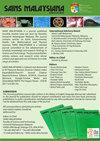Influence Mechanism of Epoxy Resin and Curing Agent on High-Temperature Performance of Asphalt
IF 0.7
4区 综合性期刊
Q3 MULTIDISCIPLINARY SCIENCES
引用次数: 6
Abstract
To deeply show the internal reasons for the effects of epoxy resin and curing agent on the high-temperature performance of asphalt, nine kinds of asphalt with different content of epoxy resin and curing agent were prepared. On the premise of ensuring that the softening point, penetration and ductility of epoxy asphalt no attenuation, the dynamic shear rheology test and Saybolt viscosity test were used to examine the rutting factor (G*/sin δ), complex shear modulus (G*), phase angle (δ), and viscosity of asphalt with different epoxy resin and curing agent contents. With the help of fluorescence microscopy, microscopic morphology was analyzed, and the micro-image was further analyzed quantitatively by using 3Dsurface and particle statistics. The results show that adding epoxy resin and curing agent into asphalt can significantly improve the rutting factor and complex shear modulus of asphalt and reduce the phase angle and the viscosity growth rate of asphalt changed from fast to slow. Fluorescence and 3Dsurface imaging results indicate when the epoxy resin and the curing agent are uniformly distributed and forms microflocculent structures, the epoxy resin can fully swell in asphalt, and the fluorescence intensity is uniform. The statistical analysis of particles shows that the improvement in high-temperature performance of asphalt by epoxy resin and curing agent results from the distribution of particle area above 26.7346 μm2. The high-temperature performance of epoxy asphalt is optimal when the content of epoxy resin and curing agent is 6 %.环氧树脂和固化剂对沥青高温性能的影响机理
为深入揭示环氧树脂和固化剂对沥青高温性能影响的内在原因,制备了9种不同环氧树脂和固化剂含量的沥青。在保证环氧沥青软化点、渗透度和延性不衰减的前提下,采用动态剪切流变试验和Saybolt粘度试验,考察了不同环氧树脂和固化剂含量沥青的车辙因子(G*/sin δ)、复合剪切模量(G*)、相位角(δ)和粘度。利用荧光显微镜对其微观形貌进行分析,并利用三维表面统计和粒子统计进一步对微观图像进行定量分析。结果表明,在沥青中加入环氧树脂和固化剂可以显著提高沥青的车辙因子和复合剪切模量,降低相角,使沥青的粘度增长速率由快变慢。荧光和三维表面成像结果表明,当环氧树脂与固化剂均匀分布并形成微絮状结构时,环氧树脂在沥青中充分膨胀,荧光强度均匀。对颗粒的统计分析表明,环氧树脂和固化剂对沥青高温性能的改善是由于颗粒面积大于26.7346 μm2。当环氧树脂和固化剂的掺量为6%时,环氧沥青的高温性能最佳。
本文章由计算机程序翻译,如有差异,请以英文原文为准。
求助全文
约1分钟内获得全文
求助全文
来源期刊

Sains Malaysiana
MULTIDISCIPLINARY SCIENCES-
CiteScore
1.60
自引率
12.50%
发文量
196
审稿时长
3-6 weeks
期刊介绍:
Sains Malaysiana is a refereed journal committed to the advancement of scholarly knowledge and research findings of the several branches of science and technology. It contains articles on Earth Sciences, Health Sciences, Life Sciences, Mathematical Sciences and Physical Sciences. The journal publishes articles, reviews, and research notes whose content and approach are of interest to a wide range of scholars. Sains Malaysiana is published by the UKM Press an its autonomous Editorial Board are drawn from the Faculty of Science and Technology, Universiti Kebangsaan Malaysia. In addition, distinguished scholars from local and foreign universities are appointed to serve as advisory board members and referees.
 求助内容:
求助内容: 应助结果提醒方式:
应助结果提醒方式:


